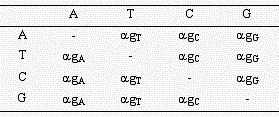
In real data, nucleotide frequencies often deviate substantially from 0.25. In this case the Tajima-Nei distance (Tajima and Nei 1984) gives a better estimate of the number of nucleotide substitutions than the Jukes-Cantor distance. Note that this assumes an equality of substitution rates among sites and between transitional and transversional substitutions.
The Felsenstein-Tajima-Nei model

MEGA provides facilities for computing the following quantities for this method:
d: Transitions + Transversions : Number of nucleotide substitutions per site.
L: No of valid common sites: Number of sites compared.
Formulas for computing these quantities are as follows:
Distance
![]()
where p is the proportion of sites with different nucleotides and

where xij is the relative frequency of the nucleotide pair i and j, gis are the nucleotide frequencies.
Variance
![]()
See also Nei and Kumar (2000), page 38.